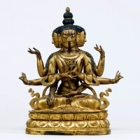東洋館 12室
2017年9月5日(火) ~ 2017年10月15日(日)
チベット仏教は、インド仏教を継承しながら、独自の発展を遂げました。なかでも密教は呪術性が強く、儀礼を重視することが知られます。そのため、教えと結びついた複雑な神仏の造形と体系が生み出されました。たとえば、インドの神々に由来する複数の顔や手をもつ異形の姿や、鳥獣や骸骨(がいこつ)といった日本ではなじみの薄いモチーフが多用されます。このような、拝する者が圧倒される造形美こそ、チベット仏教で信仰される仏像の特色といえましょう。
隣接するモンゴルや中国にもその影響は及びました。とりわけ、元(げん)や清(しん)といった王朝におけるチベット仏教への信仰は篤(あつ)く、ネパールやチベットから僧や職人が当時の首都(現在の北京)に招かれ、チベット仏教寺院の建造が相次ぎ、仏像も数多く制作されました。チベットの仏像は、中国の皇帝をも魅了してきたのです。
東京国立博物館では、チベットで制作された仏像に加え、清時代(17~19世紀)に造られた北京周辺の遺品を多数所蔵しています。本特集は、なかでも特色ある作品を選び、その豊かな信仰世界を初めてひろくご紹介するものです。ヒマラヤの高原に花開き、東アジアにも浸透したチベット仏教の神秘的な「かたち」をご覧いただければ幸いです。


